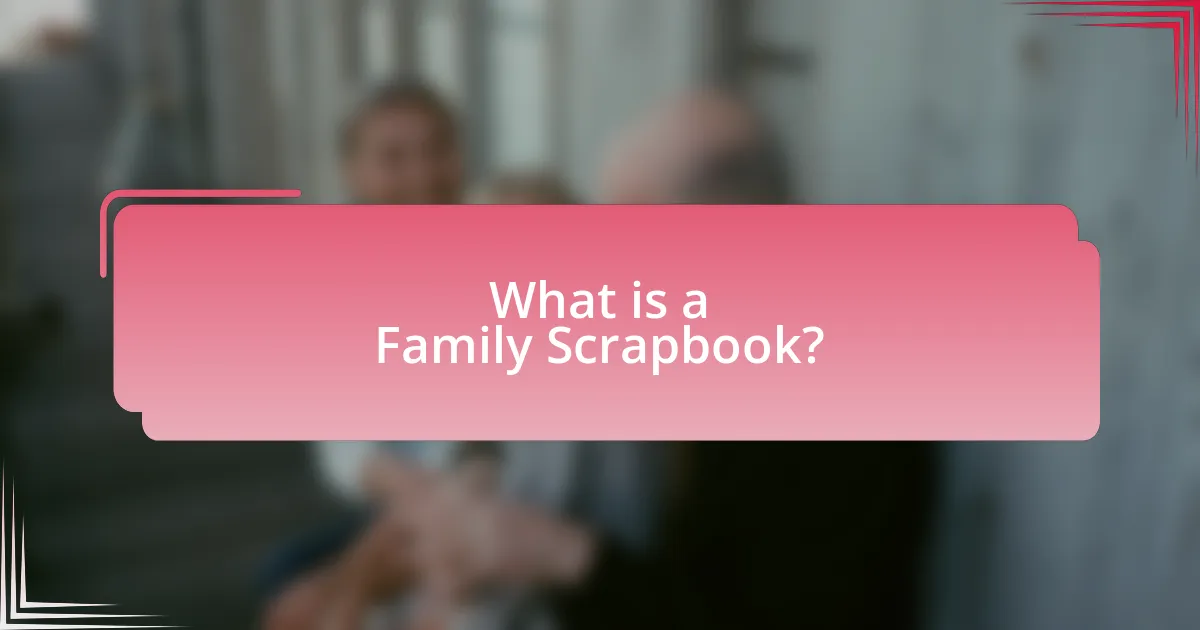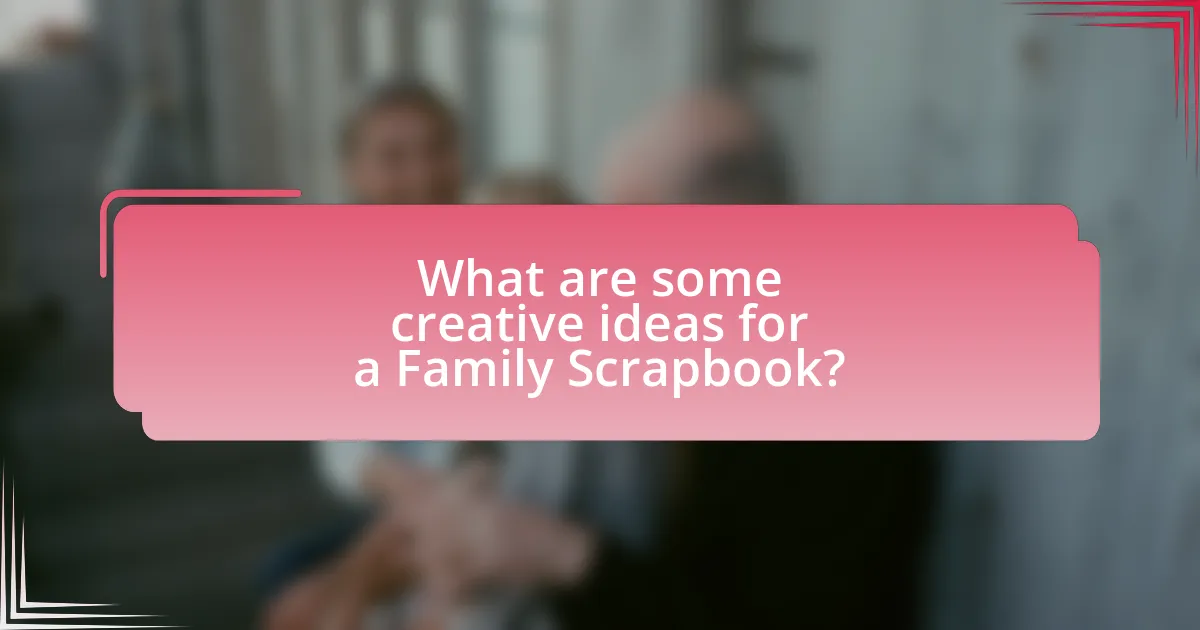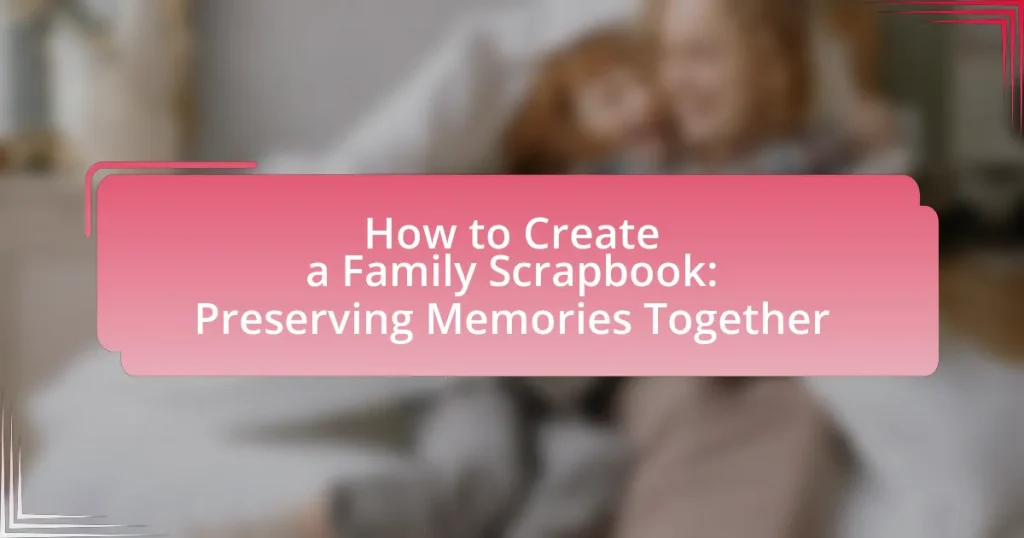A family scrapbook is a personalized collection that preserves a family’s history through photographs, memorabilia, and narratives. This article outlines the importance of creating a family scrapbook, detailing how it helps preserve memories, fosters emotional connections, and strengthens family bonds. It provides guidance on selecting materials, organizing content, and choosing themes, while also addressing common challenges and offering best practices for maintaining the scrapbook as a cherished family heirloom. Key elements such as collaboration among family members and the use of diverse media are emphasized to enhance the scrapbook-making experience.

What is a Family Scrapbook?
A family scrapbook is a personalized collection of photographs, memorabilia, and written narratives that document a family’s history and experiences. This creative project allows family members to preserve memories, celebrate milestones, and share stories across generations. Family scrapbooks often include items such as ticket stubs, letters, and drawings, which enhance the narrative and provide a tangible connection to the past. The practice of scrapbooking has been popular since the 19th century, with roots in the tradition of keeping journals and albums, making it a meaningful way to maintain family heritage.
How does a Family Scrapbook help preserve memories?
A Family Scrapbook helps preserve memories by compiling photographs, mementos, and written narratives that capture significant moments in a family’s history. This tangible collection allows families to reflect on shared experiences, fostering emotional connections and storytelling. Research indicates that engaging in creative activities like scrapbooking can enhance memory retention and emotional well-being, as it encourages individuals to process and articulate their experiences. By organizing these memories visually and contextually, a Family Scrapbook serves as a lasting record that can be revisited and cherished by future generations.
What types of memories can be included in a Family Scrapbook?
A Family Scrapbook can include various types of memories such as photographs, handwritten notes, family recipes, and mementos from significant events. Photographs capture moments from family gatherings, vacations, and milestones, while handwritten notes can express personal reflections or anecdotes. Family recipes preserve culinary traditions, and mementos like ticket stubs or event programs commemorate special occasions. These elements collectively create a tangible representation of family history and shared experiences, making the scrapbook a cherished keepsake.
Why is it important to preserve family memories?
Preserving family memories is important because it strengthens familial bonds and provides a sense of identity. When families document their experiences, they create a shared history that fosters connection and understanding among members. Research indicates that families who engage in memory preservation activities, such as scrapbooking, report higher levels of emotional well-being and cohesion. This practice not only helps individuals recall significant life events but also allows future generations to understand their heritage, contributing to a stronger family legacy.
What materials are needed to create a Family Scrapbook?
To create a Family Scrapbook, essential materials include scrapbook paper, adhesive (such as glue or double-sided tape), scissors, decorative items (like stickers and washi tape), and photo prints. These materials are fundamental for assembling and personalizing the scrapbook, allowing families to creatively document their memories. Scrapbook paper provides a base for layouts, while adhesive secures photos and embellishments. Scissors are necessary for cutting paper and photos to desired shapes, and decorative items enhance the visual appeal, making the scrapbook a cherished keepsake.
What types of paper and embellishments are best for scrapbooking?
The best types of paper for scrapbooking include acid-free cardstock, patterned paper, and specialty papers like vellum and transparency sheets. Acid-free cardstock prevents deterioration of photos and memorabilia, while patterned paper adds visual interest and variety to layouts. Specialty papers, such as vellum, provide a unique texture and can be used for overlays, enhancing the overall design.
For embellishments, stickers, die-cuts, washi tape, and brads are highly effective. Stickers offer easy decoration options, die-cuts can add intricate designs, washi tape provides versatility in borders and accents, and brads can secure layers while adding dimension. These embellishments enhance the storytelling aspect of scrapbooking by allowing for personalization and creativity.
How do tools and supplies enhance the scrapbook-making process?
Tools and supplies significantly enhance the scrapbook-making process by providing essential resources for creativity, organization, and personalization. Specific tools like scissors, adhesives, and cutting machines allow for precise cutting and assembling of materials, which improves the overall quality of the scrapbook. Additionally, supplies such as decorative papers, stickers, and embellishments enable scrapbookers to express their unique style and theme, making each project distinct. Research indicates that using high-quality materials can lead to greater satisfaction and engagement in creative activities, as noted in studies on crafting and mental well-being. Thus, the right tools and supplies not only facilitate the technical aspects of scrapbooking but also enrich the creative experience.

How do you start creating a Family Scrapbook?
To start creating a Family Scrapbook, gather essential materials such as a scrapbook album, decorative papers, scissors, glue, and writing tools. Begin by selecting a theme or focus for the scrapbook, which could be family events, vacations, or milestones. Organize photographs and memorabilia chronologically or by event, and then arrange them on the pages, adding captions or stories to provide context. This method is effective as it allows for a structured approach to preserving memories, making it easier to revisit and share family history.
What steps should you follow to begin your Family Scrapbook?
To begin your Family Scrapbook, first gather all necessary materials, including a scrapbook album, adhesive, scissors, and decorative items. Next, collect photographs, mementos, and written memories from family members to include in the scrapbook. Organize these items chronologically or thematically to create a cohesive narrative. Then, start arranging the items on the pages, ensuring to leave space for captions or stories that explain the significance of each memory. Finally, adhere the items securely and consider adding personal touches, such as drawings or notes, to enhance the scrapbook’s sentimental value. This structured approach ensures a meaningful and organized representation of family memories.
How do you choose a theme for your Family Scrapbook?
To choose a theme for your family scrapbook, first identify the central focus or purpose of the scrapbook, such as a specific event, season, or family milestone. For example, you might select a theme based on a family vacation, a holiday celebration, or a year in review. This approach helps to create a cohesive narrative throughout the scrapbook. Additionally, consider the interests and preferences of family members, as incorporating their favorite colors, styles, or activities can enhance engagement and personalization. Research indicates that themed scrapbooks can improve emotional connections to memories, making the experience more meaningful for families.
What is the best way to organize photos and memorabilia?
The best way to organize photos and memorabilia is to categorize them by themes, events, or dates. This method allows for easy retrieval and enhances storytelling within a scrapbook. For instance, grouping photos from family vacations, birthdays, or holidays creates a cohesive narrative. Additionally, using archival-quality storage materials, such as acid-free boxes and sleeves, preserves the integrity of the items. Research indicates that proper storage can extend the lifespan of photographs and memorabilia significantly, ensuring they remain in good condition for future generations.
How can family members contribute to the scrapbook?
Family members can contribute to the scrapbook by sharing personal stories, photographs, and memorabilia that represent their experiences and memories. Each family member can select significant events, such as birthdays, vacations, or milestones, and provide written narratives or captions to accompany the visuals. This collaborative effort not only enriches the scrapbook with diverse perspectives but also strengthens family bonds through shared storytelling. Research indicates that engaging in creative activities together, like scrapbooking, enhances familial relationships and promotes emotional well-being.
What roles can each family member play in the scrapbook creation process?
Each family member can take on specific roles in the scrapbook creation process to enhance collaboration and creativity. Parents can oversee the project, guiding the overall theme and layout while providing materials. Older siblings can contribute by selecting photos, writing captions, and designing pages, utilizing their skills in organization and creativity. Younger siblings can participate by decorating pages with drawings or stickers, adding a personal touch. Additionally, all family members can share stories and memories that will be included, ensuring that the scrapbook reflects collective experiences. This division of roles fosters teamwork and strengthens family bonds while preserving memories.
How can you encourage participation from younger family members?
To encourage participation from younger family members in creating a family scrapbook, involve them in the decision-making process by allowing them to choose themes, colors, and layouts. Research shows that children are more engaged when they have a say in activities, as it fosters a sense of ownership and creativity. For instance, a study published in the Journal of Family Psychology indicates that children who participate in family projects report higher satisfaction and connection with family members. By actively including younger family members in these choices, you enhance their interest and investment in the scrapbook project.

What are some creative ideas for a Family Scrapbook?
Creative ideas for a family scrapbook include incorporating themed pages for each family member, using pocket pages for memorabilia like ticket stubs and postcards, and adding interactive elements such as fold-out sections or envelopes for letters. Themed pages allow for personalized storytelling, while pocket pages provide a practical way to preserve small items that hold sentimental value. Interactive elements engage viewers and encourage family participation, making the scrapbook a collaborative project. These methods enhance the scrapbook’s visual appeal and emotional significance, ensuring that it serves as a cherished keepsake for years to come.
How can you incorporate different media into your Family Scrapbook?
To incorporate different media into your Family Scrapbook, utilize a variety of materials such as photographs, handwritten notes, digital prints, and decorative elements like stickers or washi tape. This approach enhances the visual appeal and emotional depth of the scrapbook. For instance, combining printed photos with handwritten captions allows for personal storytelling, while including digital elements like QR codes can link to videos or audio recordings, providing a multimedia experience. Research indicates that diverse media in scrapbooking can increase engagement and emotional connection, as seen in studies on memory retention and personal narrative construction.
What types of creative layouts can enhance your scrapbook pages?
Creative layouts that can enhance scrapbook pages include grid layouts, which organize photos and embellishments in a structured manner, and freeform layouts, allowing for a more artistic and spontaneous arrangement. Grid layouts provide a clean and cohesive look, making it easier to showcase multiple images, while freeform layouts encourage creativity and personal expression. Additionally, layered layouts, which involve overlapping elements for depth, and themed layouts, focusing on specific events or seasons, can also significantly enhance the visual appeal of scrapbook pages. These layout types are widely used by scrapbookers to create engaging and memorable pages that effectively tell a story.
How can you use digital tools to complement your physical scrapbook?
You can use digital tools to complement your physical scrapbook by creating digital versions of your scrapbook pages, which allows for easy sharing and printing. Digital tools such as photo editing software enable you to enhance images, add text, and create layouts that can be printed and inserted into your physical scrapbook. Additionally, using apps for organizing and storing digital photos ensures that you have a backup of your memories, making it easier to access and print them later. Research shows that integrating digital elements can enhance the overall scrapbook experience by providing versatility and creative options, as noted in studies on digital scrapbooking trends.
What themes can inspire your Family Scrapbook project?
Themes that can inspire your Family Scrapbook project include family traditions, vacations, milestones, and seasonal celebrations. Family traditions can showcase unique customs and rituals that define your family’s identity. Vacations can capture memorable trips and experiences shared together, highlighting locations and activities. Milestones can document significant life events such as birthdays, graduations, and anniversaries, emphasizing personal growth and achievements. Seasonal celebrations can reflect holidays and seasonal activities, illustrating the joy and togetherness experienced during these times. Each theme provides a structured way to organize memories, making the scrapbook a meaningful representation of family history.
How can seasonal themes be integrated into your scrapbook?
Seasonal themes can be integrated into your scrapbook by using specific colors, decorations, and layouts that reflect the characteristics of each season. For example, spring can be represented with pastel colors and floral embellishments, while autumn can feature warm tones and leaf motifs. Incorporating seasonal photographs, such as holiday celebrations or nature scenes, enhances the thematic representation. Additionally, using seasonal stickers, washi tape, and patterned papers can further emphasize the seasonal theme, making the scrapbook visually cohesive and reflective of the time of year.
What are some unique themes that reflect your family’s personality?
Unique themes that reflect a family’s personality include adventure, creativity, and tradition. An adventurous theme showcases the family’s love for travel and exploration, often highlighted through photographs and memorabilia from trips. A creative theme emphasizes artistic expression, featuring family art projects, crafts, and DIY activities that demonstrate the family’s imaginative side. A traditional theme focuses on heritage and family history, incorporating heirlooms, recipes, and stories that connect generations. These themes collectively capture the essence of the family’s identity and values, making the scrapbook a meaningful representation of their shared experiences.
What are some tips for maintaining your Family Scrapbook?
To maintain your Family Scrapbook effectively, regularly update it with new memories and photographs. This practice ensures that the scrapbook remains a current reflection of your family’s journey. Additionally, use acid-free materials to prevent deterioration of photos and memorabilia, as these materials help preserve the integrity of the items over time. Organizing the scrapbook chronologically or thematically can enhance its accessibility and enjoyment, making it easier for family members to revisit shared experiences. Regularly review and clean the scrapbook to remove dust and prevent damage, ensuring that it remains in good condition for years to come.
How can you protect your scrapbook from damage over time?
To protect your scrapbook from damage over time, store it in a cool, dry place away from direct sunlight. This prevents fading and deterioration of materials. Additionally, use acid-free materials for pages and adhesives, as these are designed to prevent yellowing and degradation. According to the Library of Congress, acid-free storage is essential for preserving paper-based items, as acidic environments can lead to irreversible damage. Regularly check your scrapbook for signs of wear or damage, and handle it with clean hands to minimize the transfer of oils and dirt.
What are best practices for storing and displaying your scrapbook?
The best practices for storing and displaying your scrapbook include using acid-free materials, keeping the scrapbook in a cool, dry place, and utilizing protective covers. Acid-free materials prevent deterioration of photos and paper, ensuring longevity. Storing the scrapbook in a cool, dry environment protects it from humidity and temperature fluctuations that can cause damage. Additionally, using protective covers, such as plastic sleeves or archival boxes, safeguards the scrapbook from dust, dirt, and physical wear. These practices are supported by archival standards that emphasize the importance of preservation techniques for maintaining the integrity of personal collections.
What common challenges might you face while creating a Family Scrapbook?
Common challenges faced while creating a Family Scrapbook include time constraints, difficulty in organizing materials, and emotional hurdles related to memories. Time constraints often arise due to busy schedules, making it hard to dedicate sufficient time for the project. Organizing materials can be challenging as families may have a variety of photos, memorabilia, and stories that need to be sorted and categorized effectively. Emotional hurdles can occur when revisiting certain memories, which may evoke strong feelings, complicating the creative process. These challenges are frequently reported by scrapbook enthusiasts, highlighting the need for planning and emotional readiness when undertaking such a project.
How can you overcome creative blocks during the scrapbook process?
To overcome creative blocks during the scrapbook process, engage in brainstorming activities that stimulate ideas. Techniques such as free writing, where you jot down any thoughts related to your scrapbook theme, can help unlock creativity. Additionally, changing your environment by working in a different location or rearranging your workspace can provide fresh perspectives. Research indicates that physical movement, like taking a walk, can enhance creative thinking by increasing blood flow to the brain. Therefore, incorporating these strategies can effectively alleviate creative blocks and enhance the scrapbook-making experience.
What solutions exist for managing time effectively while scrapbooking?
To manage time effectively while scrapbooking, individuals can implement structured planning, set specific time limits, and utilize organized materials. Structured planning involves creating a timeline for completing different sections of the scrapbook, which helps in allocating time efficiently. Setting specific time limits for each scrapbooking session, such as one or two hours, encourages focused work and prevents burnout. Additionally, organizing materials in advance, such as pre-cut papers, photos, and embellishments, streamlines the process and reduces time spent searching for items. These strategies collectively enhance productivity and ensure that scrapbooking remains an enjoyable activity rather than a time-consuming chore.
What are some best practices for creating a Family Scrapbook?
To create a Family Scrapbook effectively, start by organizing your materials and selecting a theme that reflects your family’s story. Use high-quality paper and acid-free materials to ensure longevity, as these choices prevent deterioration over time. Incorporate a variety of elements such as photographs, handwritten notes, and memorabilia to add depth and personalization. Additionally, involve family members in the process to gather diverse perspectives and memories, fostering a collaborative experience. Research indicates that engaging in creative activities together strengthens family bonds, making the scrapbook not just a collection of memories but also a tool for connection.
How can you ensure your scrapbook remains a cherished family heirloom?
To ensure your scrapbook remains a cherished family heirloom, use acid-free materials and archival-quality supplies. Acid-free paper and adhesives prevent deterioration, preserving the scrapbook’s condition over time. According to the Library of Congress, using these materials can significantly extend the lifespan of paper-based items, making them suitable for long-term storage and enjoyment. Additionally, store the scrapbook in a cool, dry place away from direct sunlight to further protect it from environmental damage.
What are the key elements to include for a meaningful scrapbook experience?
The key elements to include for a meaningful scrapbook experience are personal photographs, handwritten notes, memorabilia, and thematic organization. Personal photographs capture significant moments, while handwritten notes provide context and emotions associated with those memories. Memorabilia, such as ticket stubs or postcards, adds tangible connections to experiences. Thematic organization, whether chronological or by event, enhances the narrative flow and makes the scrapbook more engaging. These elements collectively create a rich, personalized storytelling experience that preserves family memories effectively.















